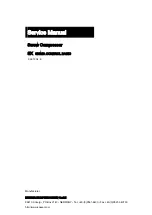
8
Do Not
touch compressor cylinder, cylinder head or pipe from head to tank as these may be hot.
8
Do Not
use this product to perform a task for which it has not been designed.
8
Do Not
deface the certification plate attached to the compressor tank.
8
Do Not
cover the compressor or restrict air flow around the unit whilst operating.
▲
DANGer! Do Not
direct the output jet of air towards people or animals.
8
Do Not
operate the compressor without an air filter.
8
Do Not
allow anyone to operate the compressor unless they have received full instructions.
WArNiNG!
The air tank is a pressure vessel and the following safety measures apply:
8
Do Not
tamper with the safety valve,
Do Not
modify or alter the tank in any way and
Do Not
strap anything to the tank.
8
Do Not
subject the tank to impact, vibration or to heat and
Do Not
allow contact with abrasives or corrosives.
WArNiNG!
If an electrical fuse blows, ensure it is replaced with an identical fuse type and rating.
9
When not in use, store the compressor carefully in a safe, dry, childproof location.
2. iNtroDuCtioN
All models feature aluminium cylinder heads with cast iron cylinders giving added resistance to wear over time. Suitable for general purpose
and workshop applications. All feature a single cylinder pump. Pump heads are directly coupled to a heavy-duty induction motor for reliable
operation. Welded tank complies with latest European standards. Fitted with fully automatic pressure cut-out switch with twin gauges
displaying tank and working pressures.
3. speCifiCAtioN
Model no: ..............................................................SAC5020A
A
ir Displacement cfm(ltr/min):
...................................
6.8(193)
M
aximum Free Air Delivery cfm(ltr/min):
...................
4.6(130)
Maximum Pressure: ...........................................
116psi(8bar)
Minimum Rated Supply: ...................................................13A
Motor output: ................................................................... 2hp
outlet: ..............................................Quick Release Coupling
Phase: .............................................................................. 1ph
Receiver Capacity: .......................................................... 50ltr
S
ize (W x D x H):
.....................................
650 x 390 x 669mm
Supply: ...........................................................................230V
noise level: ....................................................................
97dB
4. AssemblY
4.1.
Remove compressor from packaging and inspect for any
shortages or damage. If anything is found to be missing or
damaged, contact your supplier.
4.2.
Confirm that the mains voltage corresponds with the voltage shown
on the compressor data plate.
4.3.
The compressor should be installed on a flat surface, or one that
does not exceed 10
°
either transversely or longitudinally, (see
fig.2) and should be in a position that allows good air circulation
around the unit.
4.4.
The compressor is supplied without oil in it. The oil is in a separate
container. Remove the transit plug from the oil filler aperture, pour
oil into the aperture until it has reached the correct level on the
sight (fig.3). Fit the oil filler/breather supplied into the aperture.
4.5.
Ensure that the air vent in the oil filler/breather is free from debris.
If the air vent is blocked, pressure can build up in the crankcase
causing damage to the compressor and possible personal injury.
4.6.
If it is not already fitted, screw the air filter holder into the inlet port
(fig.5).
importANt
Take care when selecting tools for use with the
compressor. Air tool manufacturers normally express the volume of air required to operate a tool in cubic feet per minute (cfm). This
refers to free air delivered by the compressor (‘air out’) which varies according to the pressure setting.
Do Not
confuse this with the
compressor displacement which is the air taken in by the compressor (‘air in’). ‘Air out’ is always less than ‘air in’ - due to losses within
the compressor - and so it is important that, before choosing equipment, you study the ‘Free Air Delivery’ figures shown in the
Specification Chart.
5. operAtioN
WArNiNG!
eNsure thAt You hAve reAD, uNDerstooD AND ApplieD seCtioN 1 sAfetY iNstruCtioNs.
5.1.
Make sure that the main switch (fig.4.1) is ‘OFF’ (down).
5.2.
Check the oil level by looking through the sight glass (See fig.3B).
5.3.
Ensure that the tank drain valve is closed (fig.6).
5.4.
Close the outlet pressure regulator by turning the knob clockwise (fig.4.2).
5.5.
Connect the air tool required to the compressor via an air line connected to the air outlet.
5.6.
Plug the mains cable into the mains supply and start the compressor by pulling up the main switch.
5.7.
Allow the pressure in the tank to rise to the maximum at which point the compressor will automatically cut out. Tank pressure is shown
on the larger gauge (fig.4.5).
5.8.
Begin to gradually open the regulator by turning the knob until the small gauge registers the required operating pressure specified
for the tool to be used. Always
adjust up
to the required pressure rather than down from a higher pressure. The required setting, once
achieved, can be locked by screwing the locking ring (fig.4.3) up tight underneath the adjusting knob.
fig.1
fig.2
fig.3
Original Language Version
© Jack Sealey limited
S
AC5020A, SAC5020APK Issue 1 13/06/19

























